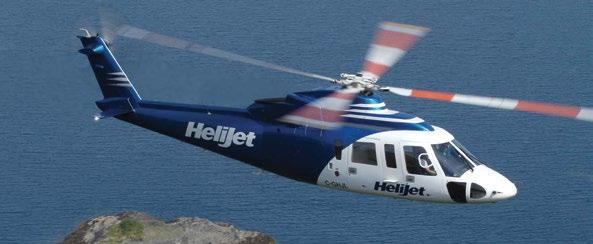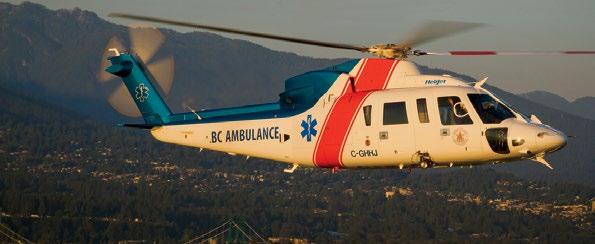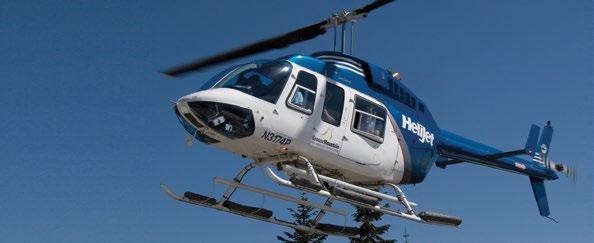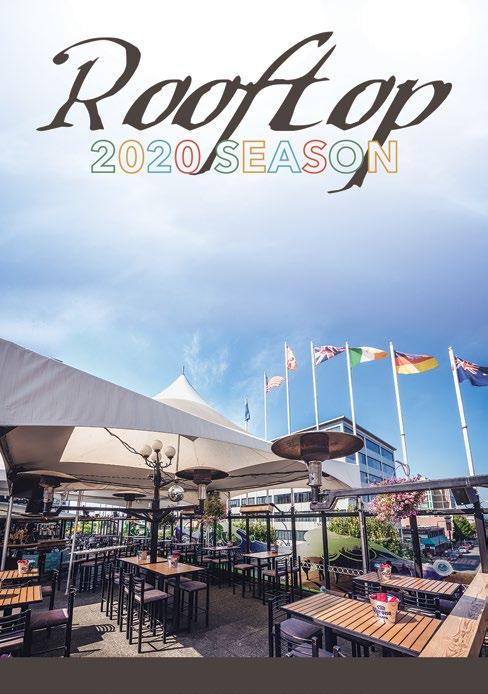

RESEARCH FOR GOOD

Ground-breaking research that harnesses the immune system to provide new clues into HIV vaccine development. The front-lines of harm reduction, overdose prevention and opioid treatment services.
We’re redefining fuel cell development. Using robotics to help wheelchair users walk again. And working with NASA to tackle the world’s water crisis.
Our researchers collaborate with government, business and community partners to accelerate transformative discoveries that will have significant social, economic and environmental impacts.
Outside thinking with tomorrow in mind.

In-Flight Review Magazine
Managing Editor: Stephanie Cunningham
Graphic Design: Brent Foote
Contributors
Stephanie Cunningham, Sue Dunham, Kevin Obermeyer, Danny Sitnam
For information on display advertising opportunities, email: info@archipelagomedia.com
Published by
Archipelago Media
1248 Woodway Road Victoria BC V9A 6Y6
Tel 250.380.3961 archipelagomedia.com
Complimentary Copy ISSN 1916-5080
In-Flight Review SUMMER 2020
Vol. 13 No. 2
In-Flight Review (IFR) is a quarterly magazine published by Archipelago Media Ltd. for Helijet International Inc. All published material is the copyright of Archipelago Media Ltd. No part of this publication, in whole or in part, may be reproduced without the written consent of the publisher. The written and photographic material published in In-Flight Review does not necessarily reflect the views of the air carrier or the publisher. Information and images produced in the magazine are believed to be accurate and truthful, but the publisher assumes no responsibility for errors.
Advertising in In-Flight Review magazine does not indicate an endorsement by Helijet International Inc. or Archipelago Media Ltd.
HELIJET FLEET

SIKORSKY S-76A

SIKORSKY S-76C+ (BC AIR AMBULANCE SERVICE)

SIKORSKY S-76C++


AS350 B2

BELL 206L3 LONGRANGER
EUROCOPTER

BY KEVIN OBERMEYER, PRESIDENT & CEO, PACIFIC PILOTAGE AUTHORITY
Seafaring Safeguard
Marine pilots protect B.C.’s coastal waters
THE NOVEL coronavirus pandemic that raced around the globe earlier this year with alarming speed was, and is, a triplethreat — straining healthcare systems, societies and economies worldwide. So far, British Columbia has fared better than many other provinces and countries in terms of confirmed cases and deaths, but a vaccine is still a long way off yet, so caution reigns. In the meantime, efforts are underway to revive the provincial and national economy.
Central to this is maritime shipping. Canada is a trading nation with much of what we buy and sell travelling by sea. Indeed, around 90 per cent of everything transported worldwide moves by ship at some point in its journey from producer to consumer. That is to say, if you count 10 random items in your living room odds are nine of them came to you from elsewhere by ship.
The job of safely navigating ships in and out of B.C.’s coastal waters falls to the Pacific Pilotage Authority (PPA), the federal crown corporation responsible for providing pilot services along the province’s 25,725 kilometres of coastline, as well as the Fraser River. Most people associate the word “pilot” with aviation,
but the term historically belongs to mariners who possess the expertise and local knowledge to safely guide seagoing ships through coastal waters and into congested harbours. By law, any foreign ship over 350 gross tons entering Canadian waters is required to have a licenced marine pilot aboard. There are 126 such pilots in B.C., and they are among the most experienced and highly trained mariners in the world. All have spent decades navigating the B.C. coast, and each undergoes rigorous selection and examinations prior to joining the PPA. Once hired, they undergo a massive training regime that continues from date of hire to retirement.
The bar is high because so much is at stake. Pilots need to have expert local knowledge and ship handling abilities because the B.C. coast is massive in scope, and one of the most challenging in the world to navigate. Moving ocean-going vessels through our littoral waters, and docking them in confined harbours, is no mean feat. Without a skilled pilot it is unlikely a large ship could safely pass through our waters and dock without jeopardizing the marine environment, as well as people and property.
Marine pilots also have a role to play in safeguarding public health. Ships calling on our shores mostly originate in Asia and as early as mid-January it became evident we needed to implement protocols to deal with a possible pandemic, just as we did with SARs and H1N1. In keeping with this, the Marine Security Operations Centre (MSOC) in Victoria makes contact with all inbound ships 96 hours prior to entering coastal waters to assess the security of the vessel and the health of its crew. MSOC then coordinates with Public Health Agency of Canada (PHAC) regarding any potential health issue onboard the vessel. The Canadian Coast Guard does another follow up 24 hours prior to the vessel entering coastal waters to assess any equipment defects or changes in crew health. Marine pilots are the third line of defence, but the first to step on board and make a visual assessment of a ship. If the security of the vessel or the health of the crew are suspect, pilots will contact MSOC and PHAC, and after discussion may put the vessel to anchor.
Because pilots are highly specialized and few in number, it is critically important we keep them healthy — for their own sake, and for the health of the economy. To that end, we are working with the federal government to source adequate masks and personal protective equipment (PPE). We have also changed the logistics for moving pilots around the province to where they are needed for assignments. For its part, Helijet has stepped up by allowing us to charter a dedicated S-76A helicopter to move pilots between Vancouver, Victoria and Nanaimo. This aircraft is regularly sanitized and provides the physical separation necessary between aircrew and marine pilots, thereby allowing us to deliver our services where they are needed.
No one knows when the economy will recover, and early numbers are not encouraging: pilot assignments for oceangoing vessels — particularly cruise ships — is well down since January, and we expect a downturn somewhere between 15 to 30 per cent for the rest of this year, and into 2021.
Whatever the case may be, the marine pilots of the PPA have a valuable role to play in maintaining the supply chain. As an essential service we will continue the important work of safely navigating ships all along the B.C. coast, with the environment and safety of Canadians always top of mind.



Photo: Jason Keel

Survival & Sustainability
This regular column is normally dedicated to profiling a Helijet employee who has made a significant contribution to our organization. In light of current events, it seems appropriate to dedicate this space to all Helijet employees rather than just one individual.
SINCE THE ARRIVAL of COVID-19, businesses everywhere are struggling to survive. The aviation industry is among the hardest hit: several airlines have shut down completely, while those still in business are limiting operations and taking drastic steps to keep the hangar doors open.
Helijet is no exception. We significantly reduced scheduled service between Vancouver, Victoria and Nanaimo, but the physical dimensions of our helicopter cabins are such that we can still provide physical distance between passengers and aircrew. As such, we are maintaining service to communities when other carriers have elected to suspend route provision for the time being. What is more, Helijet continues providing essential air service for the Pacific Pilotage Authority (PPA), and the British Columbia Emergency Health Services (BCEHS) with our fleet of dedicated Sikorsky S-76 series helicopters.
BY DANNY SITNAM, PRESIDENT & CEO, HELIJET
Out of necessity, we had to make the difficult decision to temporarily lay off a few contractual and part-time hourly staff members, but overall we have succeeded in keeping all of our full-time employees on payroll at a time when many other air carriers are choosing otherwise. Granted, the situation with COVID-19 remains fluid with very challenging months ahead, but I believe the difference between our business surviving the pandemic, and being sustainable
in a post-pandemic world, depends largely on the commitment and dedication of Helijet’s employees.
Allow me to expand: “sustainability” is one of those popular words everyone can agree on in general terms, but the specifics often elude us. Sometimes confused with “survival”, sustainability means to endure over time, whereas survival has a more immediate connotation. In the business world, most companies look to the so-called bottom line to gauge survival. Certainly, the financial pulse of any business is critical, but evidence of a heartbeat is no indication of good health, and numbers don’t tell the whole story of a company’s ability to prosper over time. Laying off large swathes of employees in a crisis might preserve cash flow in the short-term, although it may well prove ruinous in the long-term.
Here at Helijet, we believe the foundations of sustainability are cemented in relationships — specifically those our employees have developed with our customers, the communities we serve, and their fellow workers. These three pillars of success can’t be shown on a spreadsheet, but there is no question how central each is to our long-term viability.
In terms of employees, our company is blessed with a variety of talented individuals who bring enthusiasm and dedication to work every day. It is worth noting that many have devoted the best years of their working lives to Helijet. For these people, work is not just a paycheque; it is a source of professional pride, a social network, and a place to make a difference. Without their dedication and commitment, Helijet would not be able to provide the level of service our customers have come to expect.
As to our customers, many have been traveling on Helijet for years. Over time, we have developed relationships with several. Some have even become friends. And while we value all passengers equally, it is worth acknowledging the unique relationships we have developed with our friends in government, such as the BCEHS.
It has taken 34-plus years for Helijet to cultivate these relationships between employees, customers and community. The financial cost has been considerable over time, but long-term sustainability requires an organization such as ours recognize and appreciate the intangible returns derived from investing in the people who work for us, who fly with us, and where we all live. Together we will weather this storm.



Top 5 Staycation ideas
Stephanie Cunningham
By all accounts there’s no better time than the summer of 2020 to plan a staycation.
After all, every corner of British Columbia is a beautiful spot to explore — even if that spot is your own backyard.

Sleep under the stars
If your summer travel plans have been scuttled this year, consider kicking up your usual camping gear to full-on glamping. An extra-roomy tent, a cushy sleeping pad on a cot, a duvet in lieu of a slippery sleeping bag and fairy lights strung in the trees outside can all elevate the camping experience into something positively elegant and inviting. Go one step farther and line the floor of your tent with a proper area rug to give it a homey feel and to reinforce the no-shoes-in-the-tent rule.
And, if you really want to go full Out of Africa style, pack china plates instead of plastic, a tablecloth for your picnic area and vase full of flowers to set the mood.
Backyard DIY: A stylish fire bowl for roasting marshmallows is the perfect antidote to cool coastal evenings in the backyard. Pair the experience with a read-aloud from Barbara Smith’s Campfire Stories from Coast to Coast, a frighteningly fun compendium of spooky stories set across Canada, appropriate for all ages.
Pick a flick
Summer of 2020 may be the year drive-in movie theatres make their big comeback. After all, sitting in your own vehicle to watch a retro flick offers privacy, comfort and automatic social distancing that takes the guesswork out of where to sit in a traditional movie theatre. There are three remaining drive-in theatres in B.C.: the Starlight Drive-in in Enderby, the Park Drive-in in Prince George and the Twilight Drive-in in Langley. All three have made modifications to increase spacing between cars and offer advance ticket sales online to manage traffic flow.
FreshAirCinema, the Canadian-based company behind many pop-up outdoor movie events including those held at Stanley Park in years past, is planning more drivein events this year with audio broadcast through an FM signal. Upcoming events depend on approvals from local

Several years ago, while riding the ferry from Tsawwassen to Victoria, my husband and I met a couple from Texas. Their destination? Butchart Gardens. It was on their bucket list, they said, and they had driven more than 4,000 kilometres through seven states, two countries and two time zones just to enjoy its stunning floral landscape. Those of us living in B.C. may sometimes take this garden gem for granted, but the blooms are at their brightest in the glowing summer sun and its wellgroomed walkways and open spaces make it the perfect destination for physical-distance strolling.
In Vancouver, VanDusen Botanical Gardens covers 55 acres in fragrant flowers and pathways. Look for Japanese Dogwoods in June, waterlilies in July and hibiscus in August. To manage capacity this year, tickets are available for purchase online for pre-designated times.
Backyard DIY: Our temperate climate, a smidgen of effort and the right plant selections turn even the smallest plot into a vibrant oasis. Don’t know where to start? The newly updated Gardening with Native Plants of the Pacific Northwest by Arthur Kruckeberg and Linda Chalker-Scott is bursting with garden-worthy ideas and beautiful photography to help inspire and encourage even the most hesitant gardener.
Stop and smell the roses
health authorities, so keep you eyes open for new show listings on their Outdoor Movies BC Facebook page.
Backyard DIY: A backyard movie night is always a family favourite. Hang a white sheet on the fence, purchase a collapsible screen, or go bigger and better by painting a smooth wall with HD projector screen wall paint. (Pro-tip: If you choose the screen-paint option, use a darker colour to create a contrasting border reminiscent of a real screen.)
When shopping for a projector, select one that has a minimum native resolution of 720p so your image looks as sharp as possible and a luminosity of at least 600 to combat light pollution. And, for outdoor big-screen gaming, make sure your projector has a wide array of ports including HDMI, VGA and USB.


❹Take a hike ❺ Eat like a local
Whether you prefer mountain-peak views or wide ocean vistas, B.C. is a treasure map full of hidden natural gems and miles of winding trails. The only tricky part may be trying to decide which trail to tackle first. Originally published in 1976, the recently updated eighth edition of the ever-popular 109 Walks in British Columbia’s Lower Mainland by John Halliday and Alice Purdey includes 20 new trails to explore from the Sea-to-Sky Corridor to the Fraser Valley. For those on Vancouver Island, grab a guidebook
by Nanoose Bay writer Theo Dombrowski.
His Popular Day Hikes and Family Walks and Hikes of Vancouver Island are valuable resources for outdoor enthusiasts of all ages and abilities.
Backyard DIY: Southern British Columbia is an urban hikers dream, with loads of walking trails snaking through the concrete jungle. To find the trail closest to home check www.alltrails.com and zoom into your neighborhood. You might just discover a trail you never knew existed.

This summer like no other, support your community and fill up your basket with sustainable and nutritious food items direct from your local farmer’s market. There are 145plus farmers’ markets across B.C. and this year many have gone online creating digital stores so you can pre-order everything from baked goods to beef jerky, asparagus to artisan cheese. Head to the BC Farmers
Market Trail website at bcfarmersmarkettrail.com to find the market closest to you.
Backyard DIY: Named one of the Globe and Mail’s Top 100 Books that Shaped 2019, Cedar and Salt by DL Acken and Emily Lycopolus is a local cookbook like no other. Divided into four sections — forest, field, farm and sea — each recipe in the book features ingredients sourced from Vancouver Island. Pair your culinary creation with a bottle of B.C. wine and your backyard feast is complete.
A Rapid Response in the Battle Against COVID-19
BY SUE DUNHAM
Genome British Columbia is at the epicentre of the COVID-19 battle, funding much needed research to quickly address the many varied and unexpected challenges presented by this highly contagious disease. From repurposing existing drug therapies to sanitizing PPE, discover how B.C.’s research community is applying its skills to address the pandemic threat.
WEST COAST FARE WITH FLAIR
An award winning signature restaurant that defines the destination, Q at the Empress tells an authentic Vancouver Island culinary story.
By using fresh, local and seasonal ingredients sourced from our community’s fishers, forargers and artisans, Q at the Empress has established itself as the home of Vancouver Island’s most delicious West Coast Cuisine.
721 Government Street 250 384 8111 qattheempress.com
EVEN BEFORE THE province’s first case of COVID-19 was identified on January 28, B.C.’s world-class research community was already mobilized to address the new threat. Within days, Genome BC had funded the British Columbia Centre for Disease Control (BCCDC) Public Health Laboratory to incorporate genomic analysis into tracking the SARS-CoV-2 virus, adding a critical new dimension to its outbreak response capabilities.
While traditional contact-tracing techniques revealed the spread of the virus through a community, analysis of viral genetic sequences helped researchers understand the origins of new cases and the sources of outbreaks — but further research was needed. An additional $1 million in funding from the Canadian Institutes of Health Research quickly helped integrate the viral genetic data with clinical information and look for patterns predictive of the severity of the illness.
As the virus spread in the weeks that followed, identifying where a given case was initiated became even more important to understand which clusters stemmed from local transmission versus those imported from travel. Sequencing data helped to differentiate between these scenarios and informed how best to respond to this emergency, ultimately benefiting the public health of all British Columbians.

PHOTO BY: @DAMONEATS
Swift Investment, Short-term Impacts
Based on the need for rapid funding to overcome scientific challenges such as this, Genome BC and other funding organizations launched further opportunities for promising research and innovation related to COVID-19.
“We focused on funding projects that would have an impact on people within six months,” said Dr. Pascal Spothelfer, President and CEO, in an online Conversations that Matter interview with host Stu McNish. “This funding is primarily focused on delivering short-term impacts but is also intended to complement longer-term, larger funding opportunities.”
Partnerships and unique collaborations are integral to a number of these promising projects, which range in scope from new ways to sanitize personal protective equipment (PPE) for healthcare workers to assessing the viral load of COVID-19 patients.
Repurposing Existing Drug Therapies
In the search for effective drugs to treat SARSCoV-2 infection, there are speed and safety advantages to repurposing existing drugs.
To more quickly identify therapies to combat the infection, thousands of FDA-approved drugs and other clinical-stage compounds are being tested alone and in combination to see how effective they are in treating SARS-CoV-2 infections. The most promising potential therapies will be evaluated on a state-ofthe-art human airway cell platform developed by a team from the University of British Columbia and local biotech leader STEMCELL Technologies.
This project could catalyze the discovery of desperately needed candidate therapeutics for COVID-19. It also leverages the virology, drug discovery, and protein analysis expertise of an interdisciplinary, international team to create a consortium well positioned to rapidly identify lead therapeutic candidates for future emerging pathogens.
Exposed? Recovered? Immune?
Knowing if a person has had the virus is extremely important, especially for healthcare workers. To date, however, COVID-19 infection has been diagnosed solely through laboratory tests that detect the presence or absence of the virus, revealing only whether someone is currently infected, not their level of immunity. Understanding immunity requires analysis of the antibodies generated by the immune system after infection. A team based out of the BCCDC will track down the information that is urgently needed about the development, duration, and strength of the antibody responses that lead to immunity following infection with SARS-CoV-2.

Fine clothing, accessories, custom tailoring and superior service have been in our family since 1917.
We welcome you to our store in Victoria to discover the colors, texture and quality of our unique merchandise.
Fine Clothing, Sportswear & Accessories Since 1919
Fine Clothing, Sportswear & Accessories
#110-735 Yates street st. andrews square 250.384.8087 kstraith@shaw.ca www.kanestraithclothing.com
Phone: (250) 384-8087 Facsimile: (250) 595-6674 eMail: kstraith@shaw.ca
St. Andrews Square, 110-735 Yates Street, Victoria, British Columbia V8W 1L6

SEA TO SPA
After spending the morning foraging for seaweed on the shores of the Salish Sea, return to Willow Stream Spa to complete the Sea to Spa experience with the Salish Sea Vitality Body Treatment, a 90 minute journey through the waters of Vancouver Island. Complete with a massage featuring sea kelp lotion and seaweed gel; both are rich in antioxidants and vitamins to leave you feeling revitalized and refreshed.
For more information visit: fairmont.com/empress or call 250 384 8111
721 Government Street
ASPENGROVE SCHOOL
Junior Kindergarten to Grade 12

Following an assessment of four commercial antibody testing platforms, this research project will profile antibody production against SARS-CoV-2 in both newly infected and previously infected healthcare workers over three months. Findings will reveal how quickly healthcare workers develop an immune response to SARS-CoV-2, how robust this protection is against subsequent exposures, and whether there is any evidence of reinfection. This antibody data can then be used to immediately inform guidelines for healthcare workers at high risk of SARSCoV-2 exposure, including return-to-work policies and front-line deployment strategies.
Sanitizing PPE
COVID-19 patients often require aerosol-generating medical procedures, including breathing assistance. These procedures, which can disperse viral particles into the air, pose a risk for healthcare professionals who need the protection provided by filtering facepiece respirator (FFR) masks. These masks would typically be used once and then disposed of, but supply shortages could mean that masks will need to be reused if it is possible to do so safely.
admissions@aspengroveschool.ca | 250-390-2201


An innovative project led by BarrelWise Technologies aims to create and validate a heat-sterilization oven to safely decontaminate FFR masks for re-use. Heat-based sterilization methods offer a distinct set of advantages compared to other sterilization approaches such as UV and hydrogen peroxide because they require no specialty components with competitive supply-chain limitations (e.g. bulbs, ballasts, vaporizers, consumables) and the final device requires only standard wall power to operate. The goal is to create a device that can be quickly and cost-effectively manufactured by existing partners in the Lower Mainland and easily adopted in any jurisdiction.
Old Tools, New Applications
Quick and accurate identification of COVID-19 cases is essential to help stop the spread of the virus, both in the community and in hospitals and longterm care facilities. One way to improve identification of new cases is to find and address the shortcomings of current tests.
Current COVID-19 tests detect viral RNA using a tool called PCR. While PCR is a very sensitive technique to diagnose infections, there are many procedural factors that influence the quality of data produced. The way the specimen is collected, how the specimen is handled during transport, and the exact technology used in the laboratory can all affect the results. A team from Simon Fraser University aims to improve PCR testing for COVID-19 by

identifying and eliminating factors that negatively impact data quality.
It is also important to develop a method for researchers to better measure viral load in patients. Currently, nasopharyngeal swabs require close contact with the patient and the test results cannot be used to determine how much virus is present. Finding an alternative method to collect and accurately measure viral loads will help medical professionals determine which therapeutic interventions are most effective.
In the management of other viral infections such as HIV, information around viral load has been invaluable. Ultimately this work will enable the examination of the diagnostic performance of COVID-19 tests and determine viral loads of patients, which will improve the way that people are treated.
Alignment and Priorities
This pandemic is far from over and requires sustained research efforts on all fronts.
Researchers in B.C. are aligning with the province’s public health priorities as stated by the Provincial Health Officer and the BCCDC, as well as the areas of research focus highlighted by the BC COVID-19 Strategic Research Advisory Committee. These organizations are the stakeholders that will help move initiatives from research to application at this critical time and will assist B.C.’s experts as they drive innovation to makes a difference, locally and ultimately at a global level.
For more information about COVID-19 research and other ground-breaking genomics work currently underway in B.C., visit genomebc.ca.



Partnerships and unique collaborations are helping B.C.'s research community overcome the scientific challenges of COVID-19.



HIGH-PERFORMANCE HOMES
HOME ENERGY EFFICIENCY QUIZ
With the arrival of winter, take a few moments to test your knowledge of home energy efficiency:
1. What two home improvements would get you closest to being Net-Zero Ready?
a) Switch from baseboard electric heat to coal
b) Install solar panels
c) Install exterior insulation wrap
d) Upgrade to energy efficient windows
e) Both C & D
2. Of the following, which is the most cost-effective method of heating the average B.C. home?
a) Wood-burning stove
b) Solar
c) Treadmill
d) Natural gas
3. In what year will every new home need to be “Net-Zero Ready”?
a) 2022
b) 2026
c) 2032

d) I have no flaming idea what net-zero energy ready means, or how it will affect me.
4. What percentage of heat loss in the average BC home is attributed to an uninsulated slab and foundation wall?
a) Up to 30%
b) 30-50%
c) 50-75%
d) Over 75%
5. You heat the air in your home. How many times per hour do you think the volume of air changes in an older home because of a draft?
a) 10 to 20
b) 20 to 30
c) 30 to 40
d) I’m afraid to find out
KIWI KORNER: Who is the current defending champion of the America’s Cup?
a) San Diego Yacht Club
b) Royal Victoria Yacht Club
c) Lake Eyre Yacht Club
d) Royal New Zealand Yacht Squadron


See how we can help you change your life, in a changing world. Talk to us at royalroads.ca
